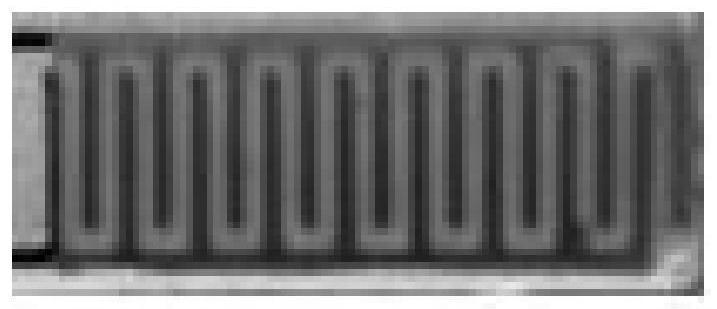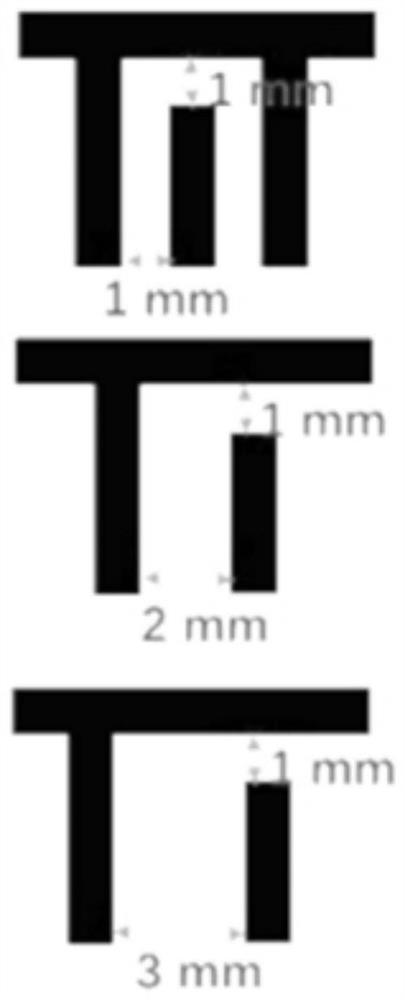Design method of multifunctional touch sensor based on 4D printing
A tactile sensor and design method technology, applied in the fields of additive manufacturing and electronic science, can solve problems such as limiting the development and application of intelligent equipment, and achieve the effects of avoiding material preparation, simple manufacturing, and low cost
- Summary
- Abstract
- Description
- Claims
- Application Information
AI Technical Summary
Problems solved by technology
Method used
Image
Examples
Embodiment 1
[0091] Stretch the polyurethane material by 40% along its length at 50°C, cool to 30°C for 1 minute, and unload the external force to obtain the stretched base layer; the multi-walled carbon with a weight ratio of 1:12 Nanotubes (CNT) and polydimethylsiloxane (PDMS) are mixed and dispersed in a mixed solution of ethanol and ethyl acetate with a mass ratio of 1:1 to form an electrode material; the electrode is composed of two sets of comb-toothed structures inserted in opposition , the height of the comb teeth is between 0.2mm and the spacing between the comb teeth is 0.1mm; the material of the pressing layer is Ecofle-0010 silicone rubber; the shape memory PU is fully dissolved with dichloromethane to realize extrusion printing; the multi-walled carbon nanotubes and The PDMS material was added to a mixed solvent of ethanol and ethyl acetate at a mass ratio of 1:12 and mixed and stirred by a planetary mixer for 30 minutes, and then the solvent was volatilized at 80°C for 8 hours...
Embodiment 2
[0094] Stretch the polyurethane material by 30% along its length at 50°C, cool to 30°C for 1 minute, and unload the external force to obtain the stretched base layer; the multi-walled carbon with a weight ratio of 1:12 Nanotubes (CNT) and polydimethylsiloxane (PDMS) are mixed and dispersed in a mixed solution of ethanol and ethyl acetate with a mass ratio of 1:1 to form an electrode material; the electrode is composed of two sets of comb-toothed structures inserted in opposition , the height of the comb teeth is between 1mm and the spacing between the comb teeth is 0.2mm; the material of the pressing layer is Ecofle-0010 silicone rubber; the shape memory PU is fully dissolved with dichloromethane to realize extrusion printing; the multi-walled carbon nanotubes and The PDMS material was added to a mixed solvent of ethanol and ethyl acetate at a mass ratio of 1:12 and mixed and stirred by a planetary mixer for 30 minutes, and then the solvent was volatilized at 80°C for 8 hours t...
Embodiment 3
[0097] Stretch the polyurethane material by 30% along its length at 50°C, cool to 30°C for 1 minute, and unload the external force to obtain the stretched base layer; the multi-walled carbon with a weight ratio of 1:12 Nanotubes (CNT) and polydimethylsiloxane (PDMS) are mixed and dispersed in a mixed solution of ethanol and ethyl acetate with a mass ratio of 1:1 to form an electrode material; the electrode is composed of two sets of comb-toothed structures inserted in opposition , the height of the comb teeth is between 1.5mm and the spacing between the comb teeth is 0.3mm; the material of the pressing layer is Ecofle-0010 silicone rubber; the shape memory PU is fully dissolved with dichloromethane to realize extrusion printing; the multi-walled carbon nanotubes and The PDMS material was added to a mixed solvent of ethanol and ethyl acetate at a mass ratio of 1:12 and mixed and stirred by a planetary mixer for 30 minutes, and then the solvent was volatilized at 80°C for 8 hours...
PUM
| Property | Measurement | Unit |
|---|---|---|
| thickness | aaaaa | aaaaa |
| thickness | aaaaa | aaaaa |
| thickness | aaaaa | aaaaa |
Abstract
Description
Claims
Application Information
 Login to View More
Login to View More - R&D
- Intellectual Property
- Life Sciences
- Materials
- Tech Scout
- Unparalleled Data Quality
- Higher Quality Content
- 60% Fewer Hallucinations
Browse by: Latest US Patents, China's latest patents, Technical Efficacy Thesaurus, Application Domain, Technology Topic, Popular Technical Reports.
© 2025 PatSnap. All rights reserved.Legal|Privacy policy|Modern Slavery Act Transparency Statement|Sitemap|About US| Contact US: help@patsnap.com



